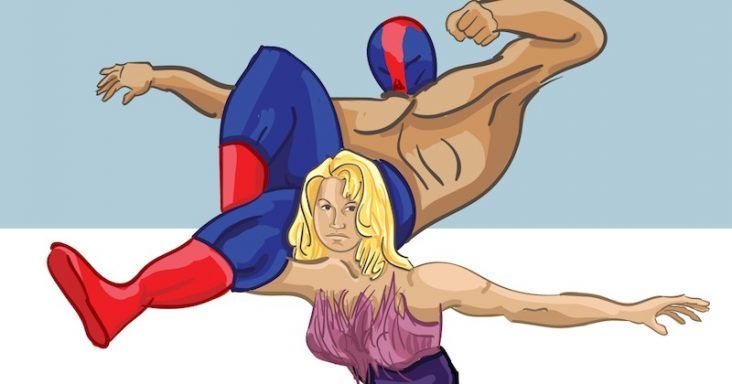Real politics of a fake sport: The history of ‘Nationality, Race and Gender’ in professional wrestling
by June 10, 2018 6:48 pm 1,421 views

When Dr. Edward Salo was growing up he loved to watch professional wrestling. During the 1980s the World Wrestling Federation, now World Wrestling Entertainment (WWE), became the dominant wrestling company. Stars such as Hulk Hogan, Andre the Giant and Salo’s favorite, The Nature Boy Ric Flair, became household names.
In the 1990s, World Championship Wrestling (WCW) emerged as a primary competitor. Early in the decade another company was formed, and Smoky Mountain Wrestling (SMW) hoped to also compete in the market. SMW covered parts of Tennessee, Kentucky, North Carolina, Virginia and other states. It existed from 1991 to 1995, but had a lasting impact on the development of wrestling themes for years, and many of them were disturbing, Salo told Talk Business & Politics.
Salo, an Arkansas State University history professor, recently wrote a chapter about SMW for a book, “Identity in Professional Wrestling: Essays on Nationality, Race and Gender.” He watched SMW while in college, and it bothered him, he said.
“I was a big wrestling fan. … I remembered how troubling the portrayals were. It was always in the back of my head to do something with it.”
SMW was founded by Jim Cornette, who was a professional wrestling booker, commentator, manager and even an occasional competitor, according to the WWE history archives. Cornette also was employed by the WCW, and there were ongoing contract disputes. He noticed when they wrestled in Southern cities – for example, Knoxville, Tenn. – there were many “traditional wrestling fans,” and he decided to develop a company that would cater to that predominantly white crowd.
Record producer Rick Rubin bankrolled the project, and the SMW was born. Some of the characters produced who would later go onto WWE fame included Chris Jericho, Road Dogg, and the first WWE Diva, Sunny (Tammy Sytch). Sunny was dating one of the SMW wrestlers outside the ring and was offered a contract in 1993. She played a villain who idolized Hillary Clinton, and in her storyline she would threaten to sue the company over feminist issues.
SEXISM AND RACISM
Salo studied many of the matches, including those with Sunny, on YouTube. Fans eagerly hated her character, and it wasn’t long before she became one of the most well-known villains in all of wrestling, he said. A few years later she moved to the WWE, and became the first woman to “sexualize” wrestling, a phenomenon that continued in the 1990s and into the 2000s. She is recognized as the first WWE Diva, and was inducted into the WWE Hall of Fame in 2011.
Racism was another key theme in SMW story lines, he said. A black tag team, The Gangstas, infuriated the primarily white audiences, Salo said. The tag team would mention O.J. Simpson and Medgar Evers to enrage the crowd. The team would win matches with the famous “two-count” to win, not a three-count, a symbolic reference, he said, to affirmative action.
“They’re angry. They’re abusive,” one television commentator said before a match and also noting that the two black men were familiar with being “frisked” by police.
The two men referred to white people as “hog-headed, tobacco-chewing, rednecks,” further perpetrating the image of the “angry black man” in one video. Often, they had to “cheat” to win, and proudly stated after matches that they cheated and didn’t care.
Themes of this kind are a part of wrestling history, Salo said. During the 1950s and 1960s German and Japanese wrestlers were cast as villains. During the 1970s Arabs became villains, and characters such as the Iron Sheik trolled audiences.
ECONOMIC DISPARITY
Another theme that played well with Southern audiences was rich versus poor, especially in the context of people from the South versus people from the North. Rich, pompous characters such as Ric Flair were seen as bad guys or “heels,” while good guys “faces,” or “baby faces” were portrayed as blue-collar and working class.
One SMW character that infuriated audiences was the Dirty White Boy, who was also called the Mighty Yankee. Southern fans flew into a fury each time he entered the ring, Salo said.
The themes were designed to illicit specific responses from the crowd, and the formula worked, Salo said. Faces were easily identified, and heels were, too. Story lines were predictable, and in the end somehow, some way, the good guy made a move to win the day, he said.
“People were more than happy to see somebody who represented something they hated get beat up,” he said.
Wrestling dynamics underwent a significant transformation as the 1990s progressed. Originally, wrestling companies made money through gate receipts, not television. Minor matches were held on television, and then if fans wanted to see premier matches they had to attend the live events. Television money and the decline of regional wrestling companies changed the economics of the sport. As it became popular nationally, racist and sex themes went into decline, although some lasted through the 1990s, he said.
Although there are aspects of wrestling that have a troubling past, Salo said he still likes the entertainment wrestling provides. On Saturdays when he was a kid he would watch matches, and then after following the action on TV, he and his friends would recreate matches with each other.
What is his favorite part of wrestling?
“A lot of people like the athleticism. … I like the story lines,” he said.
